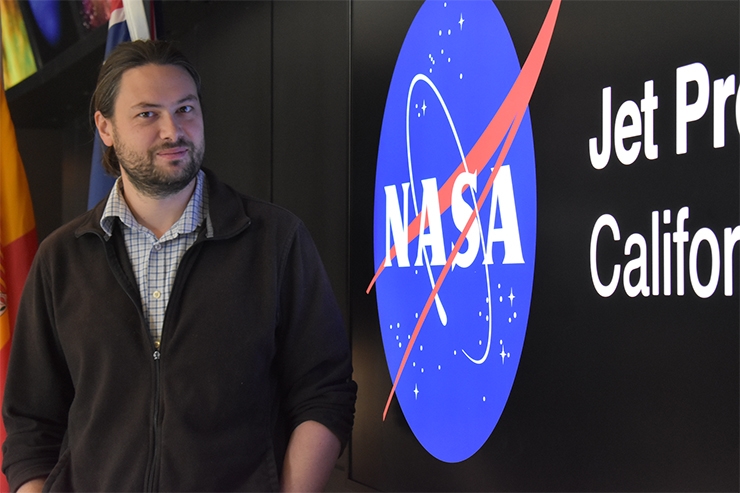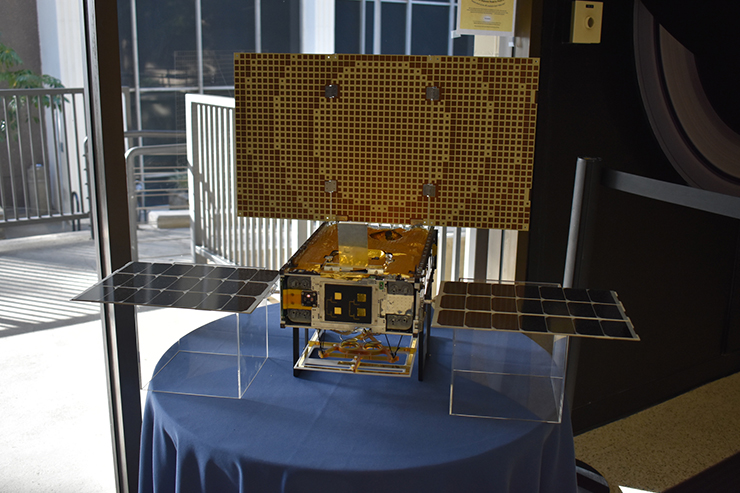UA Electrical Engineering Alumnus Takes Part in NASA's Mission History

Emmanuel Decrossas, U of A electrical engineering alumnus, works at NASA's Jet Propulsion Laboratory.
A University of Arkansas electrical engineering alumnus became part of NASA's history last year after working on a mission proving that a small spacecraft could travel into deep space and effectively transmit data back to Earth.
Emmanuel Decrossas is an engineer who specializes in radio frequency and microwave antennae for NASA. He holds a doctorate in electrical engineering from the University of Arkansas and works at NASA's Jet Propulsion Laboratory near Pasadena, California.
Decrossas and his teammates worked on MarCo CubeSat, which went to Mars alongside the 2018 InSight lander, to test the small spacecraft's capabilities of relaying InSight's data back to Earth in real time during the critical entry, descent and landing phase.
 The MarCo CubeSat model on display at Jet Propulsion Laboratory near Pasadena, California. |
The team had eight months to design and deliver the antennae.
They considered this a "high-risk, high-reward" assignment because they were developing new technology, which could take engineers years to create.
However, the technology has proven so successful that it could be used for other missions.
France, Fayetteville and Far Beyond
Decrossas moved to the United States in 2006 from Paris, France, after he received his undergraduate and master's degrees from Université Pierre-et-Marie-Curie. He said one of his advisers told him about an internship opportunity with professor Samir M. El-Ghazaly at the University of Tennessee. Decrossas applied and was accepted, becoming a visiting student scholar.
In 2007, Decrossas' mentor, El-Ghazaly, moved to Arkansas to become the head of the Electrical Engineering Department. Before leaving, El-Ghazaly encouraged Decrossas to continue his studies as a doctoral student, so Decrossas followed him to Fayetteville.
Decrossas said the freedom he had to pursue his research, in combination with the University of Arkansas' unique facilities, helped jump-start his career.
"A lot of professors have a tendency to direct you on how to do the work, but Dr. El-Ghazaly is a little bit different," Decrossas said. "He wants you to figure out the solution on your own."
That independence, El-Ghazaly said, is important for a student's success.
"When working with students, I like to let them think about the problem, identify the challenge, find a solution and then proceed to implement it," El-Ghazaly said. "At the same time, I try to guide them through it, but at first I let them figure it out."
El-Ghazaly said he believes Decrossas' accomplishments come from his motivation to dig deeper into his research and his ability to stay calm in a high-pressure environment.
"We are very proud to have our former graduate student work on such an important project," he said.
Decrossas said the University's research facilities also helped set him on his current path.
"While I was in school, something that actually helped me in my career was HiDEC (High-Density Electronics Center)," Decrossas said.
HiDEC is a research center in the Arkansas Research and Technology Park that gives graduate students the opportunity to pursue a degree with an emphasis in electronic packaging and multichip technology.
Decrossas took two classes at HiDEC, which he said exposed him to hands-on projects while gaining skills in designing and building cost-effective antennas.
"If I design a great antenna with great performances but cannot build it, it's useless," Decrossas said.
After graduating from the U of A in 2012, Decrossas applied for and received a prestigious postdoctoral fellowship from NASA, which is annually given to only 60 worldwide candidates, Decrossas said.
Decrossas' first flight project was designing antennas for a radio occultation instrument, Sentinel-6. That European mission is set to launch in 2020 and will help scientists study the layers of Earth's atmosphere and support numerical weather prediction.
He attributes his accomplishments to the experiences he had during his academic career, mentors who encouraged him and his tenacity to pursue the impossible.
"When people say 'that's impossible' or 'you cannot do it,' — that pushes me to prove them wrong," Decrossas said.
Going Farther
Decrossas' latest project will take his antenna work well beyond the inner solar system — he's now designing antennas for NASA's upcoming mission to Jupiter's moon, Europa.
Scientists hope to study the icy surface in search of clues about whether Europa's subsurface could contain an ocean with the right conditions for life.
Decrossas said he will work on predicting the performance of the 'Radar for Europa Assessment and Sounding: Ocean to Near-surface (REASON)' Instrument antennas, which is expected to help map the ice coverage.
He is expected to finish the antennas analysis by 2020 prior to the expected 2023 launch date of NASA's 'Europa Clipper.'
Topics
Contacts
Wendy Echeverria, multimedia specialist
Department of Electrical Engineering
479-575-4037,
wechever@uark.edu
Nick DeMoss, director of communications
College of Engineering
479-575-5697,
ndemoss@uark.edu
Headlines
U of A Bands to Hold Three Nights of Concerts
The Symphonic Band, the Wind Symphony, the 4 O'Clock and 5 O'Clock Bands and the Wind Ensemble will perform April 21-23 at the Faulkner Performing Arts Center on the U of A campus.
Honors College to Host 'Best in Show' Dog Celebration
The campus and community are invited to celebrate our furry friends with popsicles, water and dog treats from 3-4 p.m. Thursday, April 25, in the Gearhart Courtyard.
New Parasite Affecting Canadian Partridges Named for Arkansas Poultry Scientist
A long-time colleague in Canada gave a newly found parasite the scientific name Eimeria hargisi in honor of U of A poultry science researcher Billy Hargis.
U of A School of Law Student Selected for Ms. J.D. Leadership Academy Intensive
Tristan Branstetter-Thomas, a second-year law student, was one of 30 students from across the country chosen to participate in the leadership academy at the Northwestern Pritzker School of Law in Chicago.
Needy Honored as Distinguished Alumna of University of Pittsburgh Engineering College
College of Engineering Dean Kim Needy was among seven alumni of the University of Pittsburgh Swanson School of Engineering honored in April as part of the 2024 Class of Distinguished Alumni.




